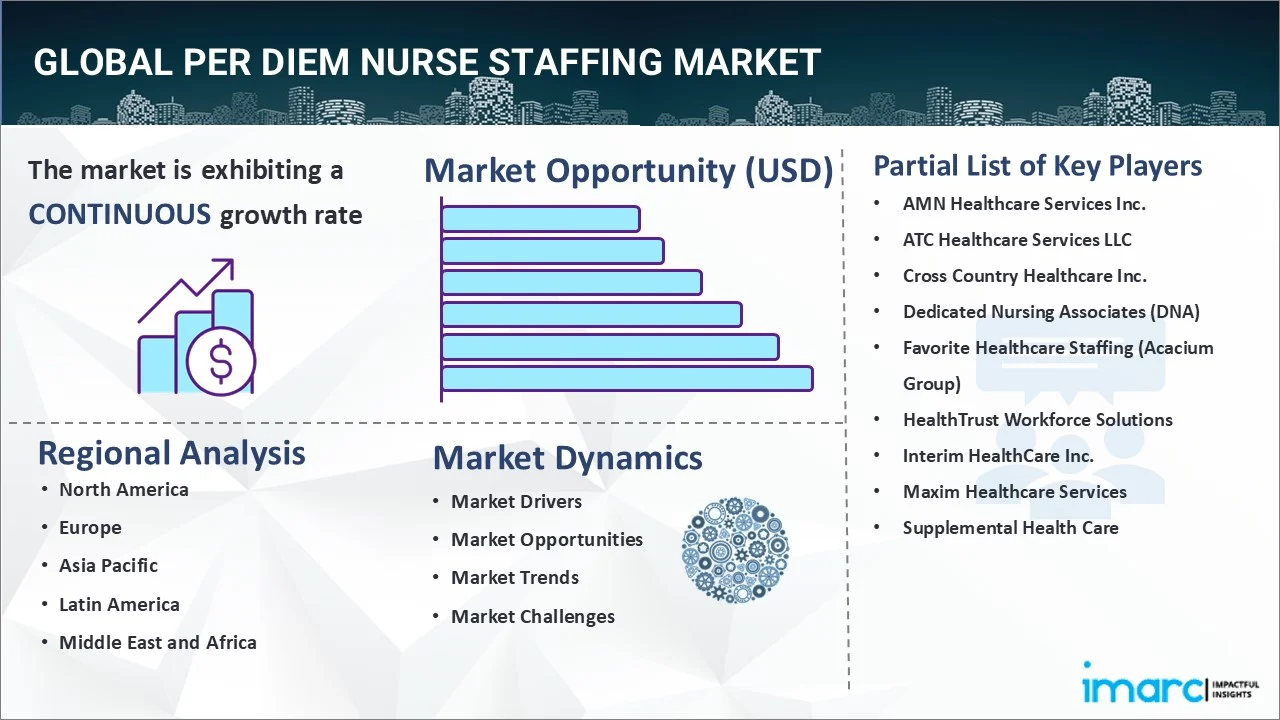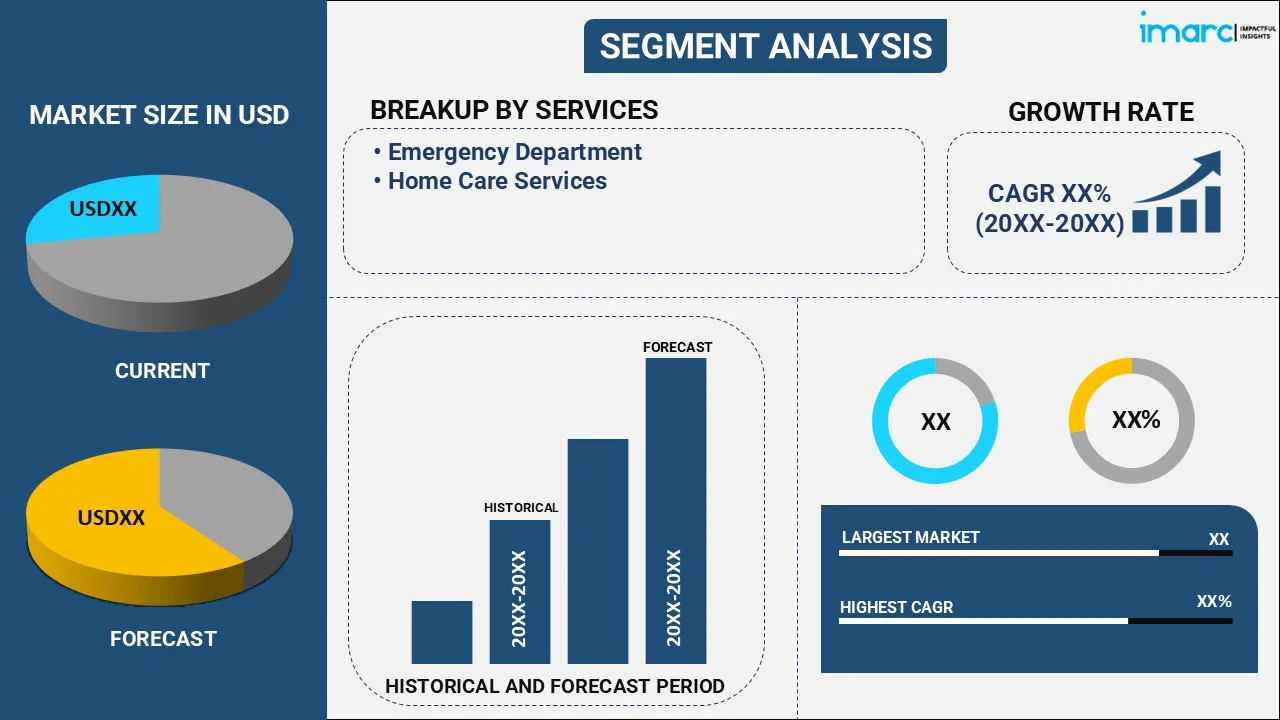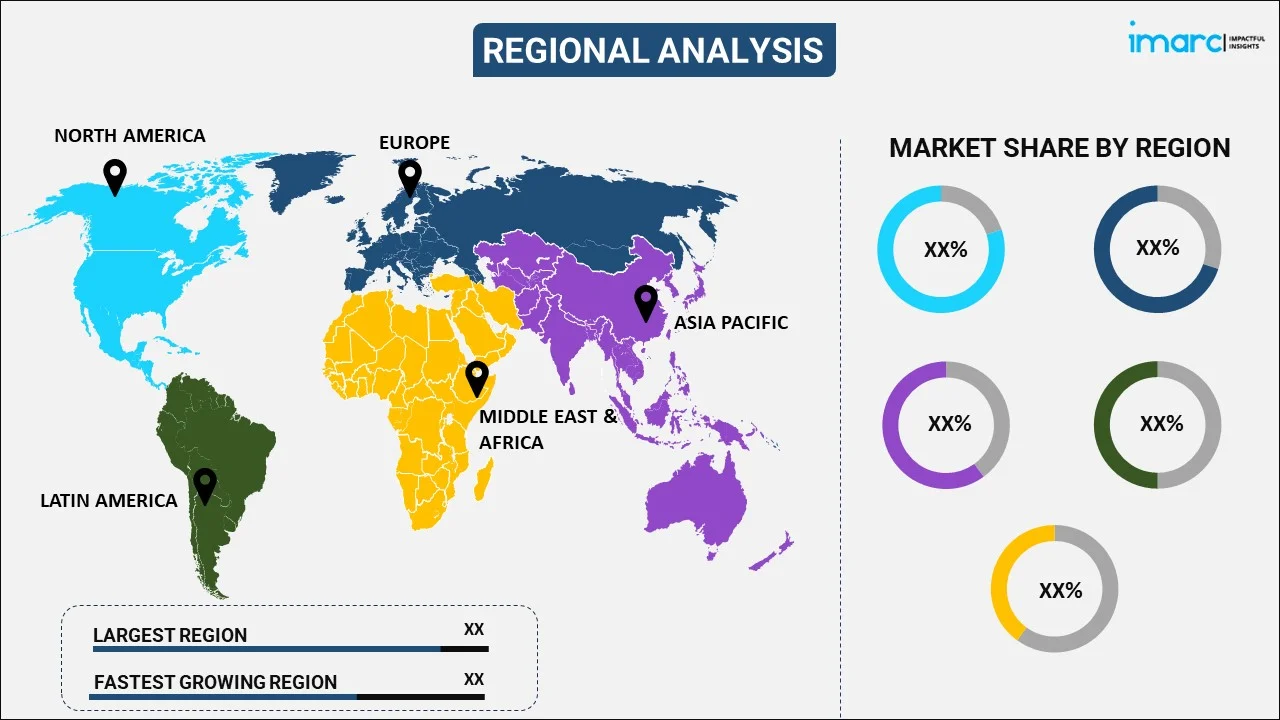
Per Diem Nurse Staffing Market Report by Service (Emergency Department, Home Care Services), End User (Hospitals, Independent Clinics, Nursing Homes), and Region 2025-2033
Market Overview:
The global per diem nurse staffing market size reached USD 9.1 Billion in 2024. Looking forward, IMARC Group expects the market to reach USD 13.7 Billion by 2033, exhibiting a growth rate (CAGR) of 4.25% during 2025-2033. The fluctuating patient volumes, recruitment challenges, cost containment needs, and the adaptability required in diverse healthcare settings are some of the major factors propelling the market.
|
Report Attribute
|
Key Statistics
|
|---|---|
|
Base Year
|
2024 |
|
Forecast Years
|
2025-2033
|
|
Historical Years
|
2019-2024
|
| Market Size in 2024 | USD 9.1 Billion |
| Market Forecast in 2033 | USD 13.7 Billion |
| Market Growth Rate 2025-2033 | 4.25% |
Per diem nurse staffing refers to the practice of hiring registered nurses and healthcare professionals on a daily basis, typically to cover temporary staffing shortages, unexpected absences, or fluctuating patient volumes. It offers healthcare facilities flexibility in managing staffing demands, ensuring that adequate care is consistently provided. Per diem nurses are not full-time employees but work on an as-needed basis, which helps healthcare institutions maintain optimal patient-to-staff ratios. This staffing model is particularly useful in maintaining quality patient care while minimizing disruptions caused by staffing gaps. It is a valuable strategy to ensure healthcare services remain uninterrupted and patient safety is upheld.

The global per diem nurse staffing market is primarily propelled by the growing demand for healthcare services. Concurrent with this, the aging population and an increased focus on healthcare access have led to fluctuating patient volumes, creating a need for flexible staffing solutions, and fueling the demand for per diem nurse staffing. In addition to this, the ongoing challenges of recruiting and retaining full-time nursing staff have prompted healthcare facilities to seek alternative staffing options, such as per diem nurses, to ensure uninterrupted patient care, thereby bolstering the market growth. Moreover, the expanding trend towards cost containment and operational efficiency in healthcare organizations has driven the adoption of per diem staffing, as it enables facilities to match staffing levels with patient demand more precisely, reducing the risk of overstaffing or understaffing. Furthermore, the rising demand for high-quality patient care while maintaining operational agility in a rapidly changing healthcare landscape is presenting lucrative opportunities for the market of per diem nurse staffing.
Per Diem Nurse Staffing Market Trends/Drivers:
Fluctuating patient volumes and demand for flexibility
One of the primary drivers of the per diem nurse staffing market is the inherent variability in patient volumes within healthcare settings. The demand for healthcare services can experience sudden spikes due to various factors such as seasonal illnesses, unforeseen emergencies, and public health crises. This unpredictable nature of patient inflows can strain the existing nursing workforce, leading to staffing shortages. Per diem nurse staffing offers a solution to this challenge by providing healthcare facilities with a pool of skilled nurses who can be engaged on a short-term basis to address these fluctuations. This adaptability allows healthcare institutions to maintain optimal patient-to-staff ratios, ensuring quality care even during peak periods.
Recruitment and retention challenges
The global healthcare industry faces persistent challenges in recruiting and retaining qualified nursing professionals. Factors such as competition for talent, high turnover rates, and demanding work conditions can hinder healthcare facilities' ability to maintain a consistent nursing workforce. As a result, healthcare organizations seek alternative staffing arrangements like per diem nursing. This approach allows facilities to tap into a diverse talent pool of experienced nurses who prefer flexible work arrangements, such as retirees, individuals seeking part-time work, or those managing other commitments. By leveraging per diem nurses, healthcare facilities can mitigate the impact of recruitment challenges and ensure that quality care is delivered without compromising staffing levels.
Operational efficiency and cost containment
In an era of healthcare cost containment and resource optimization, per diem nurse staffing offers a practical solution. Traditional full-time staffing models can lead to overstaffing during periods of lower patient demand or understaffing during peak times. Both scenarios can negatively impact patient care quality, staff morale, and overall operational efficiency. Per diem staffing enables healthcare institutions to align their staffing levels with patient volumes accurately. This helps in minimizing unnecessary labor costs associated with overstaffing while simultaneously avoiding the costs and risks associated with understaffing, such as increased patient wait times and compromised patient safety.
Per Diem Nurse Staffing Industry Segmentation:
IMARC Group provides an analysis of the key trends in each segment of the global per diem nurse staffing market report, along with forecasts at the global, regional, and country levels for 2025-2033. Our report has categorized the market based on services and end user.
Breakup by Service:

- Emergency Department
- Home Care Services
The report has provided a detailed breakup and analysis of the market based on the service. This includes emergency department and home care services.
The demand for emergency and home care per diem nurse staffing is mainly driven by the distinct requirements and challenges inherent to the healthcare sector. In emergency care, the unpredictable nature of medical crises demands immediate and agile responses. Per diem nurses provide a readily available workforce to handle surges in patient volume, ensuring that critical patient needs are met promptly and effectively. Concurrent with this, in home care settings, where patients often require personalized attention for chronic illnesses or post-hospitalization recovery, per diem nurses offer families flexible support without the commitment of full-time care. This staffing approach aligns with the individualized nature of home care and emergency services, addressing the unique demands of each context and contributing to enhanced patient outcomes and overall healthcare system resilience.
Breakup by End User:
- Hospitals
- Independent Clinics
- Nursing Homes
Hospitals hold the largest share in the market.
A detailed breakup and analysis of the market based on the end user has also been provided in the report. This includes hospitals, independent clinics, and nursing homes. According to the report, hospitals accounted for the largest market share.
The demand for per diem nurse staffing in hospitals, independent clinics, and nursing homes is fueled by distinct imperatives within each healthcare setting. In hospitals, the need for versatile staffing solutions arises from the necessity to manage diverse patient populations, specialized units, and varying levels of patient acuity. Per diem nurses offer the flexibility required to address these dynamic patient care requirements efficiently. Independent clinics, on the other hand, often need help maintaining consistent staffing levels due to budget constraints or irregular patient flows. Per diem staffing enables these clinics to access skilled nurses on an as-needed basis, optimizing resource utilization. In nursing homes, where the resident needs tend to fluctuate, and personal care is paramount, per diem nurses contribute to maintaining a high level of care delivery while accommodating variations in staff-to-resident ratios. These tailored staffing approaches address the unique demands of hospitals, independent clinics, and nursing homes, ensuring quality care delivery and operational efficiency.
Breakup by Region:

- North America
- United States
- Canada
- Europe
- Germany
- France
- United Kingdom
- Italy
- Spain
- Others
- Asia Pacific
- China
- Japan
- India
- South Korea
- Australia
- Indonesia
- Others
- Latin America
- Brazil
- Mexico
- Others
- Middle East and Africa
North America exhibits a clear dominance, accounting for the largest per diem nurse staffing market share.
The report has also provided a comprehensive analysis of all the major regional markets, which include North America (the United States and Canada); Europe (Germany, France, the United Kingdom, Italy, Spain, and others); Asia Pacific (China, Japan, India, South Korea, Australia, Indonesia, and others); Latin America (Brazil, Mexico, and others); and the Middle East and Africa. According to the report, North America accounted for the largest market share.
The aging population, rising chronic illness prevalence, and an increasing emphasis on patient-centered care in North America fuel the need for flexible staffing solutions, thereby increasing the demand for per diem nurses in the region. Besides this, the imperative to optimize healthcare spending and achieve operational efficiency in Europe aligns with the benefits offered by per diem staffing. The diverse healthcare systems across the region seek adaptable staffing models to ensure optimal resource utilization, address nursing shortages, and manage patient influxes during peak periods. Apart from this, the Asia Pacific region's rapid urbanization, evolving healthcare infrastructure, and demographic shifts contribute to dynamic patient care demands. Per diem nurse staffing caters to these fluctuating needs, particularly in countries experiencing surges in medical tourism, urbanization challenges, and skill shortages. This approach supports healthcare institutions in delivering accessible care without over-committing resources.
Competitive Landscape:
The global per diem nurse staffing market is characterized by a competitive landscape shaped by a blend of established staffing agencies, niche players, and emerging technological solutions. Prominent staffing agencies, with their extensive networks and experience, dominate the market, offering a wide range of per diem nursing services to healthcare facilities. Niche players cater to specialized healthcare sectors, focusing on delivering nurses with specific expertise, such as critical care or pediatrics. Moreover, technological advancements have introduced online platforms that connect healthcare facilities directly with per diem nurses, streamlining the hiring process. As demand rises, competition drives agencies to emphasize quality, promptness, and cost-effectiveness. To stand out, providers are diversifying their service offerings, enhancing digital platforms, and prioritizing nurse satisfaction to attract and retain skilled professionals.
The report has provided a comprehensive analysis of the competitive landscape in the market. Detailed profiles of all major companies have also been provided. Some of the key players in the market include:
- AMN Healthcare Services Inc.
- ATC Healthcare Services LLC
- Cross Country Healthcare Inc.
- Dedicated Nursing Associates (DNA)
- Favorite Healthcare Staffing (Acacium Group)
- HealthTrust Workforce Solutions
- Interim HealthCare Inc.
- Maxim Healthcare Services
- Supplemental Health Care
Per Diem Nurse Staffing Market Report Scope:
| Report Features | Details |
|---|---|
| Base Year of the Analysis | 2024 |
| Historical Period | 2019-2024 |
| Forecast Period | 2025-2033 |
| Units | Billion USD |
| Scope of the Report | Exploration of Historical and Forecast Trends, Industry Catalysts and Challenges, Segment-Wise Historical and Predictive Market Assessment:
|
| Services Covered | Emergency Department, Home Care Services |
| End Users Covered | Hospitals, Independent Clinics, Nursing Homes |
| Regions Covered | Asia Pacific, Europe, North America, Latin America, Middle East and Africa |
| Countries Covered | United States, Canada, Germany, France, United Kingdom, Italy, Spain, China, Japan, India, South Korea, Australia, Indonesia, Brazil, Mexico |
| Companies Covered | AMN Healthcare Services Inc., ATC Healthcare Services LLC, Cross Country Healthcare Inc., Dedicated Nursing Associates (DNA), Favorite Healthcare Staffing (Acacium Group), HealthTrust Workforce Solutions, Interim HealthCare Inc., Maxim Healthcare Services, Supplemental Health Care, etc. |
| Customization Scope | 10% Free Customization |
| Post-Sale Analyst Support | 10-12 Weeks |
| Delivery Format | PDF and Excel through Email (We can also provide the editable version of the report in PPT/Word format on special request) |
Key Questions Answered in This Report:
- How has the global per diem nurse staffing market performed so far, and how will it perform in the coming years?
- What are the drivers, restraints, and opportunities in the global per diem nurse staffing market?
- What is the impact of each driver, restraint, and opportunity on the global per diem nurse staffing market?
- What are the key regional markets?
- Which countries represent the most attractive per diem nurse staffing market?
- What is the breakup of the market based on the service?
- Which is the most attractive service in the per diem nurse staffing market?
- What is the breakup of the market based on the end user?
- Which is the most attractive end user in the per diem nurse staffing market?
- What is the competitive structure of the global per diem nurse staffing market?
- Who are the key players/companies in the global per diem nurse staffing market?
Key Benefits for Stakeholders:
- IMARC’s report offers a comprehensive quantitative analysis of various market segments, historical and current market trends, market forecasts, and dynamics of the per diem nurse staffing market from 2019-2033.
- The research study provides the latest information on the market drivers, challenges, and opportunities in the global per diem nurse staffing market.
- The study maps the leading, as well as the fastest-growing, regional markets. It further enables stakeholders to identify the key country-level markets within each region.
- Porter's five forces analysis assist stakeholders in assessing the impact of new entrants, competitive rivalry, supplier power, buyer power, and the threat of substitution. It helps stakeholders to analyze the level of competition within the per diem nurse staffing industry and its attractiveness.
- Competitive landscape allows stakeholders to understand their competitive environment and provides an insight into the current positions of key players in the market.
Need more help?
- Speak to our experienced analysts for insights on the current market scenarios.
- Include additional segments and countries to customize the report as per your requirement.
- Gain an unparalleled competitive advantage in your domain by understanding how to utilize the report and positively impacting your operations and revenue.
- For further assistance, please connect with our analysts.
 Request Customization
Request Customization
 Speak to an Analyst
Speak to an Analyst
 Request Brochure
Request Brochure
 Inquire Before Buying
Inquire Before Buying




.webp)




.webp)












